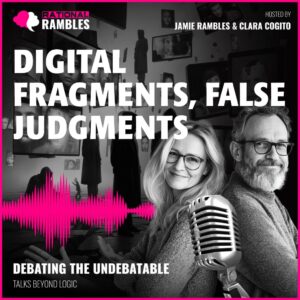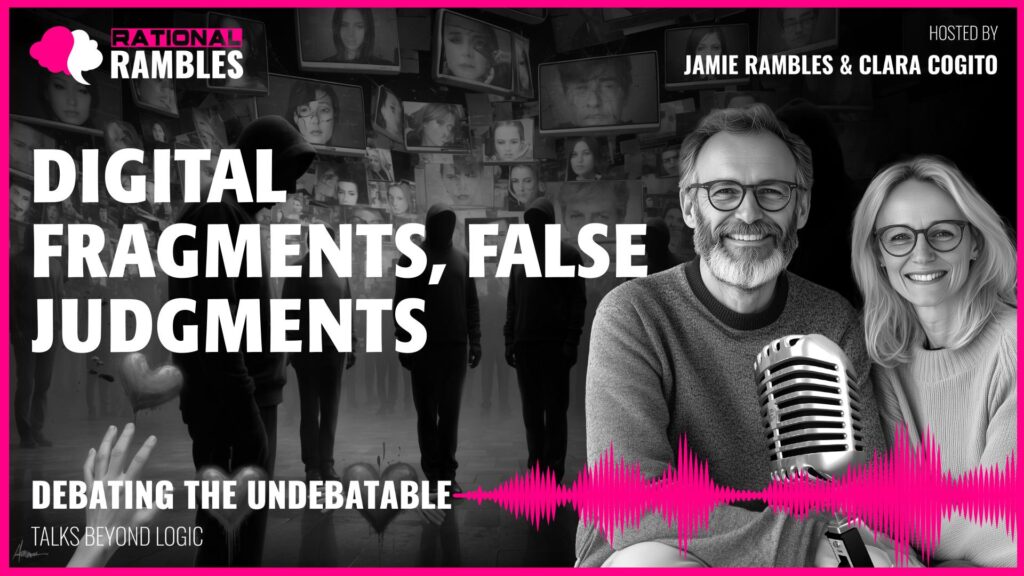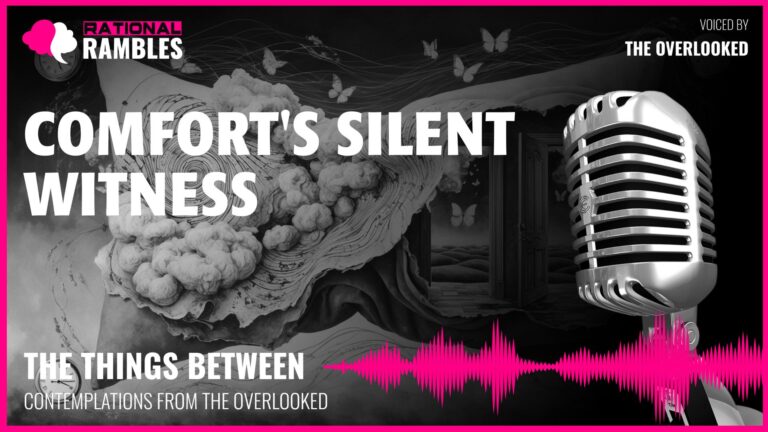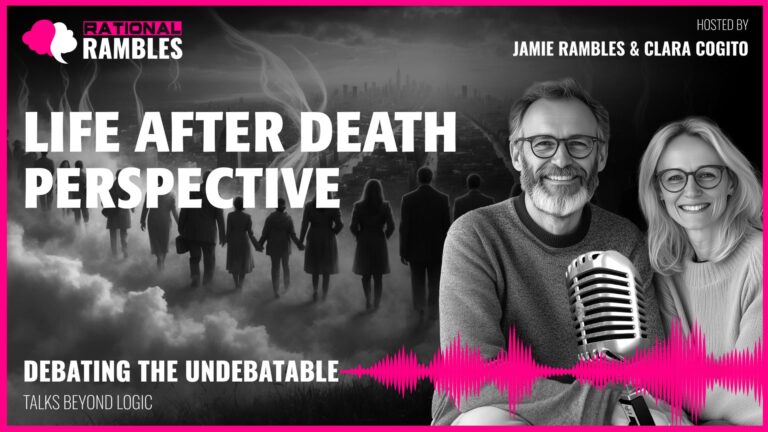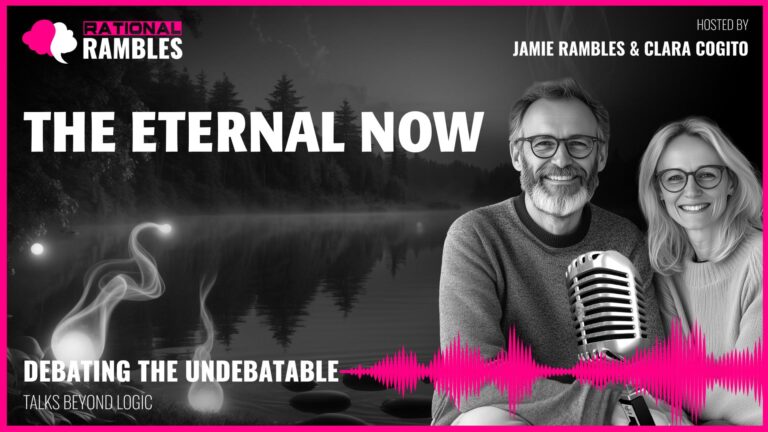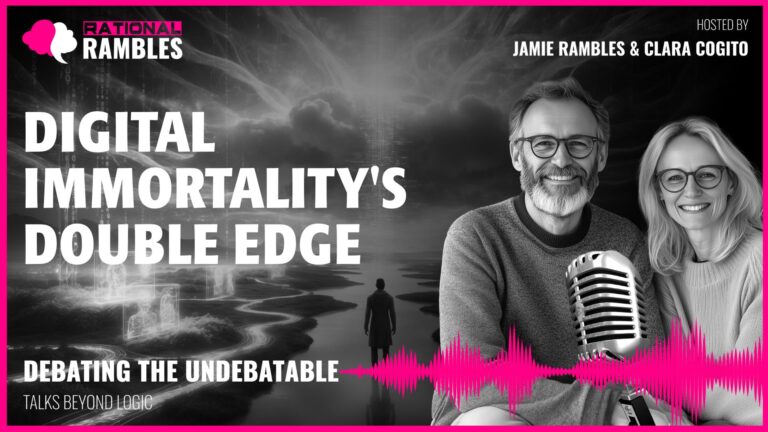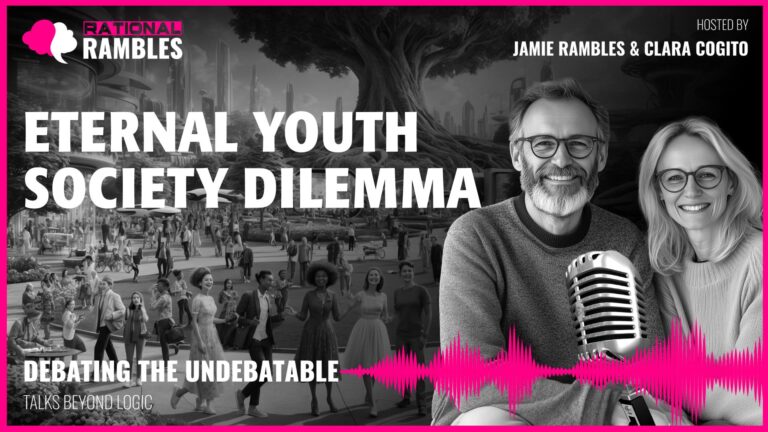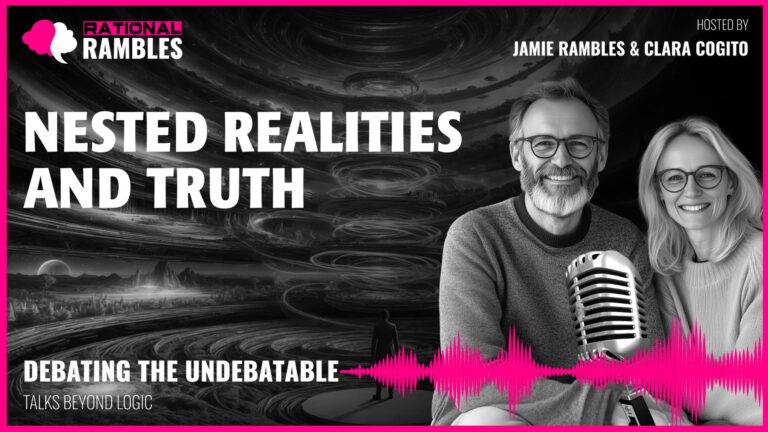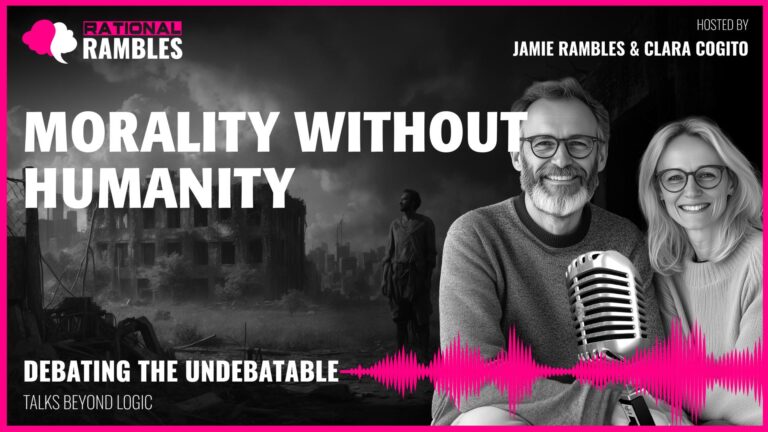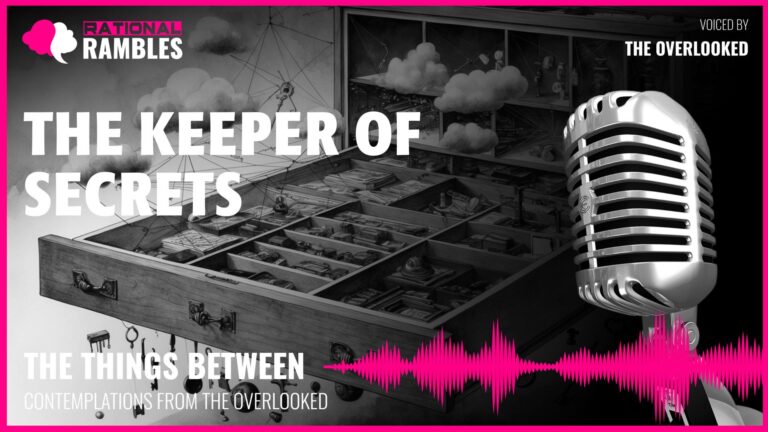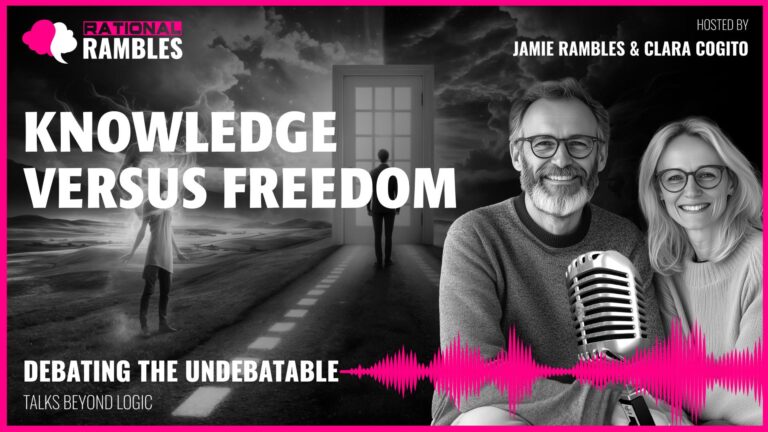Digital Fragments, False Judgments: The Epistemology of Parasocial Relationships in the Digital Age
Introduction
In an era where social media platforms dominate our daily interactions, a curious psychological phenomenon has taken center stage in how we relate to others—particularly those we’ve never met. Parasocial relationships, once limited to one-sided attachments to television personalities or movie stars, have evolved into complex webs of presumed intimacy in the digital age. We scroll through carefully curated fragments of public figures’ lives and piece together narratives about who they are, what motivates them, and even what they should do next. This essay explores the philosophical and psychological underpinnings of these digital relationships, examining how limited fragments of information lead to confident judgments, the ethical implications of this epistemic overreach, and what it means for human connection in the digital era.
The phenomenon transcends mere celebrity gossip, touching on fundamental questions about knowledge, moral authority, and human dignity. When millions of strangers collectively construct narratives about individuals based on digital snippets, they engage in what might be called “parasocial judgment”—a form of epistemic presumption that deserves serious ethical consideration. This examination sits at the intersection of epistemology, psychology, ethics, and media studies, offering insights into one of the most pervasive yet under-examined features of contemporary digital life.
The Anatomy of Digital Presumption
Traditional parasocial relationships, first identified by researchers Donald Horton and Richard Wohl in 1956, described the illusory connections television viewers formed with media personalities. These relationships were clearly demarcated as one-way; viewers understood, at least implicitly, that Johnny Carson or Walter Cronkite wasn’t actually their friend. The digital landscape, however, has fundamentally transformed this dynamic through what can be termed “digital presumption”—the belief that visibility equals access to authentic selves.
Unlike television, social media creates a persistent illusion of reciprocity. When a celebrity or influencer responds to comments, shares seemingly intimate moments from their daily life, or speaks directly to the camera, the boundary between performance and authenticity blurs significantly. The fragments visible to followers—carefully selected Instagram posts, 280-character thoughts, or curated video clips—create the impression of comprehensive knowledge.
The Illusion of Intimacy
What makes digital presumption particularly potent is its simulation of intimacy. Studies in media psychology have found that regular exposure to a person’s digital content triggers the same neurological pathways involved in forming actual friendships. Research by Anthropologist Robin Dunbar suggests humans can meaningfully track social relationships with approximately 150 people—the famous “Dunbar’s number.” Yet social media creates the illusion that we can meaningfully follow thousands, leading to cognitive architecture operating beyond its design parameters.
The irregular but persistent nature of social media updates mimics the pattern of real-world friendship maintenance. We don’t see our actual friends every minute of every day; we catch glimpses of their lives through conversations, shared experiences, and occasional deep discussions. Social media mimics this pattern while removing the reciprocal obligations of true friendship. The parasocial follower receives the psychological benefits of connection without the responsibilities of mutual care and consideration.
From Fragments to Narratives
The human mind is a pattern-seeking instrument. When presented with fragments, it naturally constructs cohesive narratives to make sense of disparate information. This cognitive tendency—beneficial in many contexts—becomes problematic when applied to digital fragments of others’ lives. Research in cognitive psychology demonstrates that the fewer actual data points available about emotionally salient subjects, the more elaborate the cognitive constructions built around them.
Consider how this operates in practice: A public figure posts a photograph looking tired, followed a week later by canceling a scheduled appearance. From these minimal data points, followers might construct elaborate narratives about the person’s mental health, relationship status, or career trajectory. The narrative feels complete despite being built on the flimsiest evidential foundation. This pattern-seeking behavior operates largely below conscious awareness, making it particularly difficult to counteract.
Parasocial Judgment: The Epistemological Error
Beyond mere narrative construction lies a more troubling dimension: the confidence with which these narratives transform into judgments. This phenomenon—”parasocial judgment”—represents a significant epistemological error where people claim to know not just facts about public figures but intimate truths about their character, intentions, and even what would be best for them. This represents a collective abandonment of epistemic humility, the philosophical principle that acknowledges the limitations of what we can truly know.
Parasocial judgment manifests in statements like: “She’s clearly struggling with depression but refusing to get help,” or “His relationship is obviously toxic, but he can’t see it,” or “She’s making these career choices for attention rather than artistic integrity.” These statements reveal remarkable confidence despite being based on severely limited information, often filtered through multiple layers of public relations management.
The Fundamental Attribution Error Magnified
This phenomenon directly connects to what social psychologists call the “fundamental attribution error”—our tendency to attribute others’ behaviors almost entirely to their character or intentions while underestimating situational factors. In everyday life, this cognitive bias leads us to judge the person who cuts us off in traffic as “a reckless driver” rather than considering situational explanations (perhaps they’re rushing to a hospital emergency).
In digital contexts, this error operates at unprecedented scale. When a public figure makes an ambiguous statement, posts content that could be interpreted multiple ways, or makes a mistake, the fundamental attribution error leads millions to attribute these actions primarily to character flaws rather than contextual factors. The digital environment, with its lack of context and nuance, amplifies this tendency dramatically.
Research by psychologist Lee Ross, who originally identified the fundamental attribution error, suggests this bias is particularly difficult to correct because it operates pre-consciously, shaping our perceptions before rational analysis begins. Digital media’s emphasis on immediate reaction further exacerbates this problem by encouraging rapid judgment before reflective processes can engage.
Testimonial Injustice in Digital Spaces
Philosopher Miranda Fricker’s concept of “testimonial injustice” provides another valuable lens for understanding parasocial judgment. Testimonial injustice occurs when someone’s word is given less credibility than it deserves due to prejudice. In digital contexts, we observe a peculiar inversion where public figures’ own statements about their experiences or intentions are routinely dismissed in favor of collective interpretation.
When a public figure states, “That’s not what I meant” or “You’ve misunderstood my intentions,” these clarifications are often treated as less authoritative than the audience’s interpretation. This represents a form of epistemic overreach where the collective audience claims interpretive authority over the individual’s own experience. This pattern reveals a troubling power dynamic where the crowd’s narrative supersedes individual testimony about one’s own mental states—a domain where first-person authority should be strongest.
The Ethics of Digital Presumption
Beyond the epistemological problems of parasocial judgment lie serious ethical concerns. When we construct elaborate narratives about others based on digital fragments, we risk treating them as characters rather than autonomous beings with complex inner lives. This connects directly to Immanuel Kant’s ethical principle that people should be treated as ends in themselves, never merely as means to our entertainment, moral posturing, or psychological gratification.
The ethical dimension becomes particularly troubling when parasocial judgment masquerades as care or concern. Statements like “I’m just worried about her” or “I want what’s best for him” recast boundary violations as virtuous acts of care. This represents what psychologists call “moral licensing”—using positive moral framing to justify potentially problematic behaviors.
Non-Consensual Care
A crucial ethical insight emerges when we recognize that parasocial concern is fundamentally non-consensual. The public figure never requested this supposed care, yet it’s used to justify extraordinary intrusions into their private life and character. This creates what might be termed “non-consensual care”—a boundary violation disguised as virtuous concern.
This connects to Thomas Nagel’s famous philosophical argument in “What Is It Like to Be a Bat?”—we can never truly know the subjective experience of another being. Yet parasocial relationships involve not only claiming to know another’s experience but presuming to know what’s best for them based on that limited knowledge. This represents both an epistemological error and an ethical overreach.
The Distributed Responsibility Problem
Hannah Arendt’s analysis of how responsibility diffuses in group settings helps illuminate another troubling aspect of parasocial judgment. In digital spaces, responsibility diffuses among participants in a way that obscures individual accountability. No single comment or speculation seems particularly harmful, yet collectively they create a boundary violation that no individual would claim responsibility for.
This creates a pernicious cycle: Person A makes a minor presumptive comment, Person B builds on it, Person C escalates further, and suddenly an elaborate narrative exists that no individual would have created alone. Each person makes what seems a minor contribution, but the cumulative effect represents a significant ethical breach. This diffusion of responsibility makes addressing the problem particularly challenging, as no individual feels personally responsible for the collective harm.
Psychological Mechanisms and Cognitive Biases
Understanding the psychology behind parasocial judgment helps explain why these patterns persist despite their questionable epistemological and ethical foundations. Several key psychological mechanisms contribute to this phenomenon, operating largely below conscious awareness.
Context Collapse
Communication theorists describe “context collapse” as the flattening of multiple audiences—friends, family, colleagues, strangers—into a single context on social media platforms. This disrupts our usual social boundaries and contextual norms, creating situations where behaviors that would be inappropriate in one context become normalized because the contextual cues governing social boundaries are absent.
In traditional social contexts, different norms govern how we discuss close friends versus acquaintances versus public figures. Context collapse erases these distinctions, applying intimate friendship norms to public figures while simultaneously broadcasting judgments to vast audiences—a combination that would be considered inappropriate in pre-digital contexts.
Belief Perseverance and Confirmation Bias
Once a narrative about a public figure forms, contradictory information is often ignored or reinterpreted to fit the established view. Psychologists call this “belief perseverance”—the tendency for beliefs to persist even after the evidence supporting them is contradicted.
This creates a troubling trap for public figures: if they attempt to correct misperceptions, their corrections are often incorporated into the original narrative as further “evidence.” A celebrity denying relationship problems might be interpreted as “clearly in denial” rather than truthfully reporting their experience. This creates a kind of unfalsifiable judgment where all evidence, even contradictory evidence, reinforces the original theory.
Research by psychologist Raymond Nickerson demonstrates that confirmation bias—our tendency to search for and favor information that confirms existing beliefs—operates more strongly in emotionally charged situations and when we’ve publicly committed to a position. Both conditions are frequently present in digital discussions about public figures.
System 1 vs. System 2 Thinking
Psychologist Daniel Kahneman’s distinction between “System 1” thinking (fast, intuitive, and emotional) and “System 2” thinking (slower, more deliberative, and logical) helps explain why digital media environments particularly encourage parasocial judgment. The speed and emotional engagement of social media platforms naturally activate System 1 processes, which are more prone to cognitive biases and hasty judgments.
Digital media’s emphasis on immediate reaction—commenting, sharing, liking—creates a environment where System 1 dominates. The temporal compression of these platforms gives little space for the reflective pause that might activate System 2 processes, which would be more likely to question the sufficiency of evidence and recognize the limitations of what can be known from digital fragments.
Cultural and Historical Dimensions
While digital parasocial relationships represent a contemporary phenomenon in their current form, they connect to broader cultural and historical patterns of public fascination with prominent figures. Examining these connections provides valuable context and potential insights for addressing current challenges.
Cross-Cultural Variations
Research in cross-cultural psychology suggests significant variations in parasocial dynamics across different cultural contexts. Collectivist cultures, which emphasize group harmony over individual expression, often demonstrate different patterns of celebrity engagement compared to individualistic Western societies.
For example, studies of East Asian celebrity culture reveal greater emphasis on celebrities maintaining formal public personas rather than the Western ideal of “authentic” self-disclosure. This creates different expectations about what can and should be known about public figures, potentially offering alternative models for understanding the appropriate boundaries of parasocial relationships.
Research by cultural psychologists Hazel Rose Markus and Shinobu Kitayama suggests these differences stem from fundamental variations in construals of the self—independent versus interdependent—that shape all social relationships, including parasocial ones. These cultural variations remind us that current Western patterns of parasocial judgment are not universal or inevitable.
Historical Precursors
While modern technology has transformed parasocial relationships, public fascination with prominent figures has historical precedents. The obsessive public interest in figures like Lord Byron, Oscar Wilde, or Marie Antoinette shares characteristics with modern parasocial relationships. Historical accounts describe avid readers poring over every published detail about Byron’s life, speculating about his character and relationships based on fragments of information.
What distinguishes contemporary parasocial relationships is primarily scale and immediacy. Historical figures were subjected to public judgment, but not in real-time by millions simultaneously, and they maintained greater separation between public and private spheres. The temporal distance between a public figure’s actions and public reaction allowed more space for deliberation and perhaps greater recognition of the limitations of public knowledge.
This historical perspective suggests that while the basic psychological tendencies underlying parasocial relationships may be persistent aspects of human nature, their current manifestation is shaped by specific technological and social conditions that could potentially be modified.
Ethical Responses and Potential Interventions
Recognizing the epistemological and ethical problems of parasocial judgment leads naturally to the question of appropriate responses. What individual practices and collective interventions might foster healthier engagement with public figures’ digital content?
Cultivating Epistemic Humility
At the individual level, cultivating what philosophers call “epistemic humility”—recognition of the limitations of what we can know—represents a crucial first step. This connects to the Socratic wisdom of knowing what we do not know, applied to digital contexts. Practically, this might involve the simple practice of pausing before judgment to ask, “How could I know this with certainty?”
Research in metacognition—thinking about thinking—suggests that explicitly questioning the basis of our judgments can significantly reduce confident but unfounded assertions. Psychological studies show that imagining alternative explanations for observed behaviors helps counter the fundamental attribution error, reducing our tendency to make confident character judgments based on limited information.
Structural Interventions and Platform Design
Beyond individual practices, structural interventions through platform design could support more thoughtful digital engagement. Research in behavioral economics and “choice architecture” demonstrates that subtle design features can guide behavior without restricting freedom.
Promising interventions include features that introduce friction into the judgment process—such as prompts asking users to consider if their comment is based on sufficient information, reminders about the partial nature of what they’re seeing, or tools that facilitate imagining alternative interpretations. Early research suggests these small interventions can significantly reduce reactive judgment patterns.
A 2021 study by researchers at the University of Pennsylvania found that simple prompts asking social media users to consider the limitations of their knowledge before commenting reduced confident character judgments by 37% in experimental settings. Similar approaches could be implemented more broadly on major platforms.
Educational Approaches
Media literacy education represents another promising avenue for intervention. Traditional media literacy focuses primarily on evaluating the credibility of information sources, but digital epistemology education would address the proper stance toward knowledge claims about others based on digital content.
Recent developmental psychology research suggests adolescents—whose identity formation processes make them particularly susceptible to parasocial relationships—can be explicitly taught critical skills for healthier digital engagement. Educational programs that incorporate lessons on parasocial relationships, cognitive biases, and epistemic limitations show promising results in helping young people develop more nuanced attitudes toward digital content.
Integrating philosophical concepts like epistemic humility and testimonial justice with psychological insights about cognitive biases creates particularly robust educational approaches. When students understand both the mechanisms at work and the ethical principles at stake, they develop more sophisticated approaches to digital engagement.
The Future of Digital Relationships
As digital technologies continue to evolve, parasocial relationships will likely transform in both predictable and surprising ways. Emerging technologies present both new challenges and potential opportunities for healthier digital connections.
Technological Intensification
Emerging technologies like augmented reality (AR) and virtual reality (VR) could potentially intensify parasocial illusions by creating even more immersive but still fundamentally one-sided experiences. As public figures appear in increasingly realistic immersive environments, the line between authentic interaction and parasocial simulation may blur further.
The development of sophisticated AI-driven digital humans raises additional questions about how parasocial dynamics might operate when the object of attachment isn’t even a real person but a convincing simulation. Research on human-AI interaction suggests people readily form emotional attachments to digital entities even while consciously aware of their non-human nature.
Cultural Adaptation and Digital Disillusionment
Counterbalancing technological intensification are emerging signs of what might be called “digital disillusionment”—increasing awareness of the limitations of digital connections and hunger for more authentic engagement. As public understanding of digital media’s limitations grows, cultural norms may evolve to place greater value on epistemic humility and recognition of the partial nature of digital knowledge.
Research on media effects across generations shows evidence of increasing sophistication in how younger users approach digital content. Digital natives who have grown up with social media often demonstrate more nuanced understanding of its constructed nature than older adults who adopted these technologies later in life. This suggests the possibility of cultural learning and adaptation over time.
The future likely holds neither complete immersion in parasocial illusion nor its complete rejection, but rather an evolving balance as technologies advance and cultural understanding deepens. This co-evolution of technology and cultural norms represents a crucial arena for both research and thoughtful intervention.
The Recognition of Full Personhood
At its core, the ethical challenge of parasocial judgment concerns the recognition of others’ full personhood. When we reduce public figures to characters in narratives constructed from digital fragments, we engage in a subtle form of dehumanization, regardless of how compassionate our intentions may be.
I-It vs. I-Thou Relationships
Philosopher Martin Buber’s distinction between “I-It” relationships, where others are treated as objects to be analyzed and used, and “I-Thou” relationships that recognize full personhood provides a valuable framework. Parasocial judgments transform what should be I-Thou recognition of another’s irreducible subjectivity into I-It objectification, where the person becomes an object of analysis rather than a subject with their own experience.
What makes this particularly troubling is that this objectification often occurs under the guise of care or concern, giving it a veneer of moral legitimacy. The psychological mechanism of “reaction formation”—where one emotion (perhaps judgment or the desire to control) is unconsciously transformed into its opposite (concern or protection)—allows people to satisfy unconscious motives while maintaining a positive self-image.
Toward Digital Ethics of Recognition
Moving toward healthier digital engagement requires developing what might be called a “digital ethics of recognition”—practices that acknowledge the full personhood of those we encounter online, including public figures we know only through digital fragments.
Such ethics would recognize that all human beings, regardless of their public visibility, deserve to be treated as subjects rather than objects, as ends rather than means. It would acknowledge the fundamental limitations of what can be known about others through digital fragments and maintain appropriate epistemic humility in the face of these limitations.
Most importantly, it would recognize that true care for others involves respecting boundaries rather than presuming intimate knowledge or judgment. A digital ethics of recognition would distinguish between legitimate public discussion of public actions and the presumption of access to private motives, feelings, or experiences.
Conclusion
The phenomenon of parasocial judgment—confidently assessing others based on digital fragments—represents a significant epistemological and ethical challenge of our digital age. By examining the psychological mechanisms, philosophical dimensions, and ethical implications of these judgments, we can develop both individual practices and collective interventions that foster healthier digital engagement.
What makes this issue particularly compelling is how it connects contemporary digital behaviors to enduring philosophical questions about knowledge, judgment, and human relationships. The specific technological context may be new, but the fundamental human challenges of knowing others, respecting boundaries, and treating people as ends rather than means remain consistent across time.
As we navigate increasingly complex digital environments, cultivating epistemic humility, thoughtful platform design, and education in digital ethics offers a path toward relationships characterized by greater respect for the limitations of what can be known and deeper recognition of others’ full personhood. In doing so, we might transform our digital relationships from exercises in presumptive judgment into opportunities for genuine, if limited, understanding.
References
Dunbar, R. I. M. (2018). The anatomy of friendship. Trends in Cognitive Sciences, 22(1), 32-51.
Fricker, M. (2007). Epistemic injustice: Power and the ethics of knowing. Oxford University Press.
Horton, D., & Wohl, R. R. (1956). Mass communication and para-social interaction: Observations on intimacy at a distance. Psychiatry, 19(3), 215-229.
Kahneman, D. (2011). Thinking, fast and slow. Farrar, Straus and Giroux.
Markus, H. R., & Kitayama, S. (1991). Culture and the self: Implications for cognition, emotion, and motivation. Psychological Review, 98(2), 224-253.
Nagel, T. (1974). What is it like to be a bat? The Philosophical Review, 83(4), 435-450.
Nickerson, R. S. (1998). Confirmation bias: A ubiquitous phenomenon in many guises. Review of General Psychology, 2(2), 175-220.
Ross, L. (1977). The intuitive psychologist and his shortcomings: Distortions in the attribution process. In L. Berkowitz (Ed.), Advances in experimental social psychology (Vol. 10, pp. 173-220). Academic Press.


